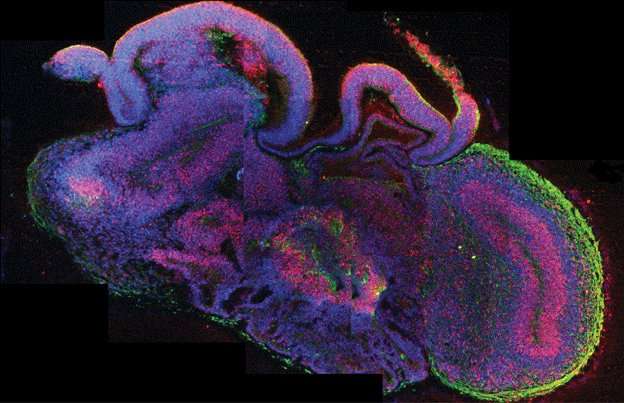For 10 months, scientists from the Institute of Molecular Biotechnology (IMBA) at the Austrian Academy of Sciences (OeAW) fed and cared for a tiny cluster of cells. With the correct mixture of nutrients, chemical environment, and appropriate coaxing, the researchers successfully cultured miniature brains that are still functioning today—10 months later.
The brains were grown from human stem cells derived from the skin. Researchers identified growth conditions that helped the stem cells differentiate into several types of brain tissues. They grew the stem cells on a synthetic gel that resembled natural connective tissues found in the brain and elsewhere in the body before placing these clumps of cells in a spinning vessel, known as a bioreactor, in order to enhance nutrient absorption and infuse them with oxygen.
The purpose of this research was to develop a model by which to study developmental brain disorders, including microcephaly, a condition that results in stunted brain growth and cognitive impairment.
Microcephaly is difficult to replicate in rodents due to species-specific differences in brain development. These miniature brains provided a resource the team could harness in order to grow and study human organs affected with the disorder.
According to developmental neurobiologist at the University of California, Arnold Kriefstein, in an interview with Nature, the study confirmed many prevailing theories about microcephaly. The brains grew to a smaller size than expected, but replicating the disorder in these model tissues allowed scientists to discover other potential causes for microcephaly than previously discussed.
Although the miniature brains do not function as a cohesive unit—normal brain maturation requires growth signals from other parts of the body—scientists may be able to develop larger and more complex neural-tissue clumps in the future. These tissues could be used to model other disorders besides microcephaly, especially if researchers can learn more about controlling cell growth reliably.
“This whole approach is really in its early stages,” Kriefstein told Nature. “The jury may still be out in terms of how robust this [technique] is.”
These miniature brains are not the only model organ currently being grown. Scientists at a variety of prestigious institutes around the globe have recently announced success in steps towards engineering functioning organs from stem cells. Researchers in Japan have developed functional human liver tissue in a petri dish from reprogrammed skin cells, while several teams have reported progress on developing kidney tissue in a similar fashion.








